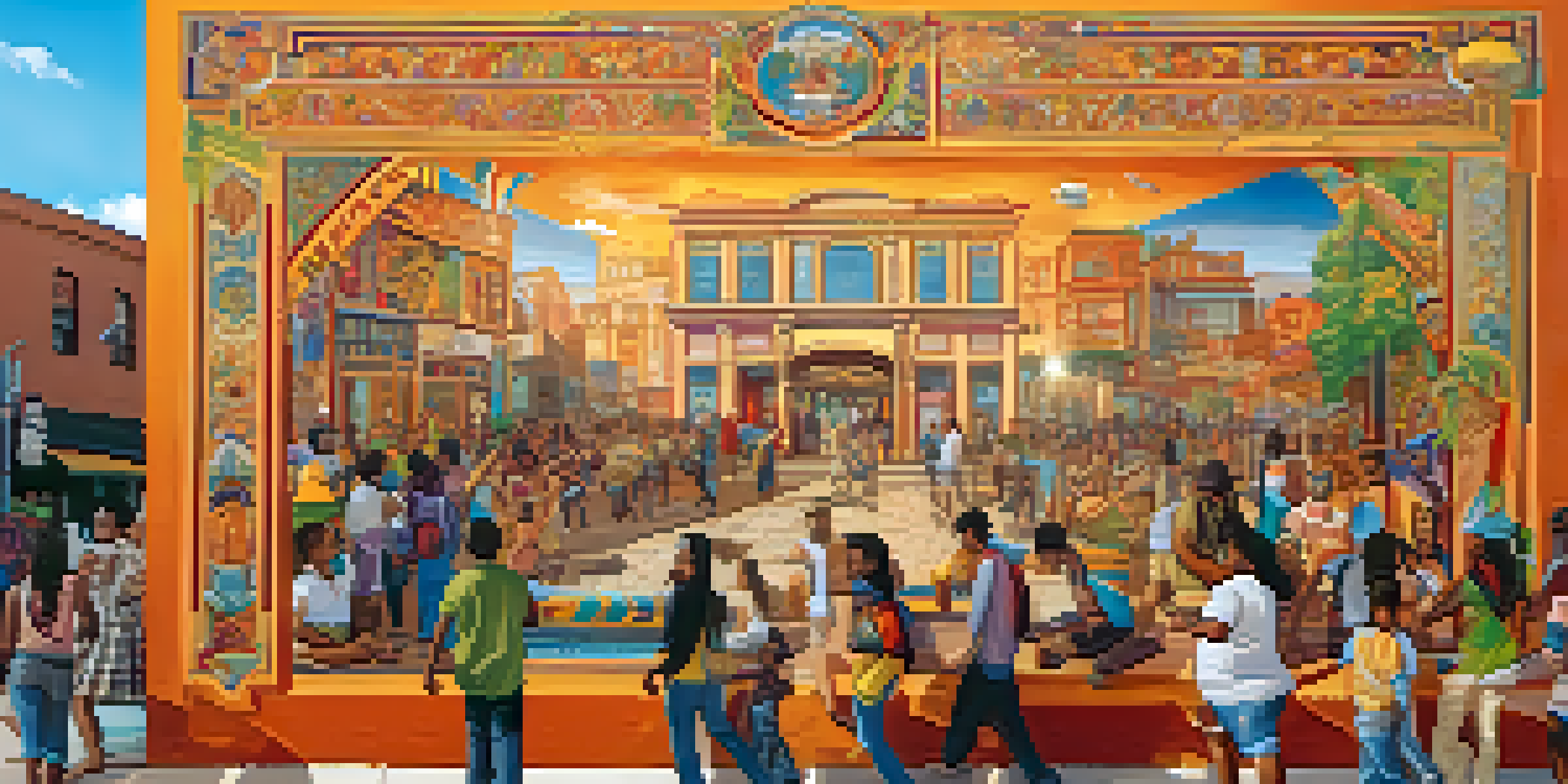Art and Identity: How Personal Background Shapes Creativity

Understanding the Connection Between Art and Identity
Art and identity are deeply intertwined, reflecting who we are and where we come from. Each brushstroke, note, or word often carries the weight of personal experiences and cultural influences. For instance, a painter from a coastal town may find inspiration in the ocean, while a writer from a bustling city might draw from its vibrant energy. This intersection of personal background and creativity enriches the artistic landscape.
Every artist dips his brush in his own soul, and paints his own nature into his pictures.
When artists channel their identity into their work, they create pieces that resonate on multiple levels. Their unique perspectives invite viewers to engage with the art in a more profound way. Think of a mural depicting a community’s history; it tells a story that is both personal and communal, bridging individual experiences with collective identity. In this way, art can serve as a powerful medium for self-expression.
Moreover, the act of creating art can also be a form of self-discovery. Artists often explore their backgrounds, questioning and redefining their identities through their work. This process can lead to healing, empowerment, and a deeper understanding of oneself, making the relationship between art and identity a dynamic and transformative experience.
Cultural Influences on Artistic Expression
Cultural background plays a significant role in shaping artistic expression. Elements like traditions, customs, and societal norms can heavily influence an artist's style and themes. For example, Indigenous artists often incorporate symbols and narratives from their heritage, creating art that not only reflects their identity but also educates others about their culture. This cultural lens adds layers of meaning to their work.

Furthermore, exposure to various art forms can broaden an artist's perspective. An artist raised in a multicultural environment may blend different styles and techniques, resulting in a unique fusion of influences. This cross-cultural exchange can lead to innovative creations that celebrate diversity. It emphasizes the idea that art is not just an individual endeavor but also a collective one, shaped by the world around us.
Art Reflects Personal and Cultural Identity
Art serves as a profound medium for self-expression, intertwining personal backgrounds and cultural influences to resonate on multiple levels.
Ultimately, cultural backgrounds provide artists with a rich tapestry of inspiration. Whether it’s through folklore, music, or visual art, these influences foster creativity and help to carve out an artist's niche within the broader art community. This interplay between culture and creativity showcases how our identities are woven into the fabric of our artistic endeavors.
Personal Experiences That Shape Creative Voices
Personal experiences are often the bedrock of an artist's voice. Moments of joy, sorrow, or struggle can deeply inform the themes explored in their work. For instance, an artist who has faced adversity may create pieces that reflect resilience and hope, offering a glimpse into their personal journey. These experiences add authenticity to their art, resonating with audiences who may share similar stories.
Art is the most beautiful of all lies.
Moreover, the environment in which an artist grows up can significantly impact their creative output. An artist from a rural area might find inspiration in nature, while someone from an urban setting might focus on the hustle and bustle of city life. These environmental factors help to shape not just the subject matter, but also the techniques and mediums used in their art.
In many cases, artists consciously or unconsciously draw from their past to inform their current work. This retrospective approach allows them to reflect on their identities, fostering a deeper connection with their audience. By sharing their personal narratives, artists invite others to explore their own experiences, creating a shared space for understanding and empathy.
The Role of Family and Community in Shaping Art
Family and community can significantly influence an artist's development. From a young age, the support and encouragement from family can nurture creativity and instill confidence. For example, a child raised in a household filled with art supplies and creative discussions is likely to develop a passion for artistic pursuits. This foundational support can be crucial in shaping an artist's journey.
Community also plays a vital role in providing inspiration and resources. Local art groups, workshops, and cultural events can help artists connect with others and hone their skills. Networking within a creative community can lead to collaborative projects that enhance artistic expression. These shared experiences foster a sense of belonging and validation, empowering artists to explore their identity through their work.
Community Shapes Artistic Development
The support from family and the inspiration drawn from community experiences play a crucial role in nurturing an artist's creative journey.
Additionally, the stories and traditions passed down through generations can influence an artist's style and subject matter. An artist may draw on folklore or community history, weaving these elements into their creations. This connection to family and community not only enriches their work but also serves to preserve and celebrate their cultural heritage.
Globalization and Its Impact on Artistic Identity
In today's interconnected world, globalization has transformed how artistic identity is expressed. Artists now have access to a wealth of influences from around the globe, which can both enrich and complicate their creative processes. For instance, an artist may blend traditional techniques from their culture with contemporary styles from abroad, creating a dialogue between past and present. This fusion can result in groundbreaking work that resonates with diverse audiences.
However, globalization can also raise questions about authenticity and cultural appropriation. Artists must navigate the fine line between drawing inspiration from other cultures and respecting their origins. This awareness can lead to more thoughtful and intentional artistic practices that honor the source material while also celebrating individual creativity. It emphasizes the importance of understanding the cultural significance behind artistic elements.
Ultimately, globalization presents both opportunities and challenges for artists. It encourages a broader exploration of identity and creativity, pushing boundaries and expanding horizons. By engaging with a myriad of influences, artists can create works that not only reflect their personal backgrounds but also resonate with a global audience.
The Intersection of Identity and Artistic Techniques
The techniques an artist chooses often reflect their personal background and identity. For instance, an artist from a textile-rich culture may incorporate weaving or fabric into their work as a nod to their heritage. This choice not only showcases their skills but also tells a story about their identity, bridging the gap between tradition and contemporary art. The techniques become a canvas for self-expression.
Moreover, the medium an artist selects can also be a reflection of their experiences. An artist who has faced social challenges might gravitate towards street art, using public spaces as a platform for their voice. This choice transforms their art into a form of activism, allowing their identity and message to reach a wider audience. Thus, the medium becomes an extension of their identity.
Globalization Influences Artistic Practice
Globalization enriches artistic identity by providing access to diverse influences, prompting artists to blend traditional and contemporary styles.
In this way, the intersection of identity and artistic techniques creates a rich dialogue within the art. Artists use their backgrounds as a springboard to explore new methods and styles, pushing the boundaries of traditional art forms. This evolution not only showcases their growth as artists but also emphasizes the ongoing relationship between identity and creativity.
Finding Authenticity in Artistic Expression
Authenticity is a crucial element in artistic expression, often rooted in personal identity. Artists who embrace their backgrounds and experiences tend to create more meaningful and impactful work. When artists are true to themselves, their art resonates with honesty and vulnerability, inviting viewers to connect on a deeper level. This authenticity can be a powerful catalyst for change and understanding.
However, the journey to finding one's authentic voice can be challenging. Artists may grapple with societal expectations, self-doubt, or the desire to conform to trends. Yet, those who push through these obstacles often emerge with a clearer sense of their identity and creative purpose. This process of self-discovery is not only essential for artistic growth but also reflects the broader human experience.

Ultimately, the quest for authenticity shapes the narrative of an artist's work. By embracing their unique backgrounds and experiences, artists can craft narratives that speak to universal themes of identity, belonging, and resilience. This journey not only enriches their artistic practice but also inspires others to explore and celebrate their own identities through creativity.